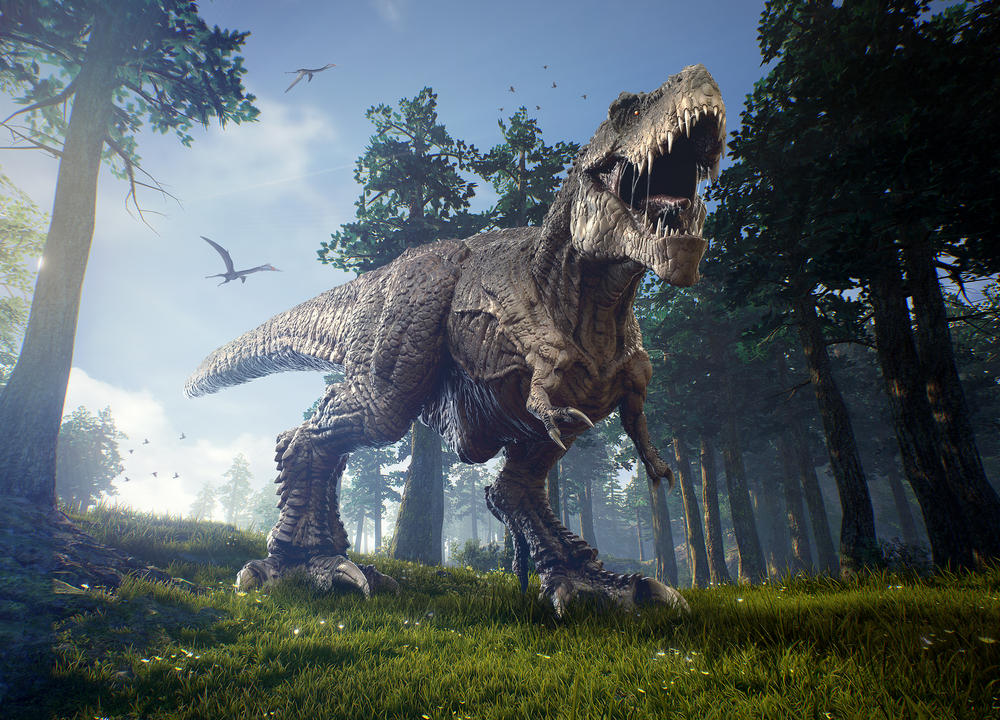Over 40 Percent Of Americans Believe Humans And Dinosaurs Co-Existed, According To One Poll

Imagine a world where humans and dinosaurs roamed the Earth together — a scene straight out of cartoons and summer blockbusters. For a surprising number of Americans, this idea isn’t fiction, but fact. According to a widely-cited poll, millions genuinely believe our ancient ancestors might’ve crossed paths with creatures like the T. rex and the triceratops.
How did this belief become so common, and what does it reveal about our understanding of science, history, and the power of storytelling? The answers may surprise you — and they go far beyond simple misinformation.
The Poll Breakdown
In 2015, a YouGov poll asked Americans a straightforward question: Did humans and dinosaurs ever live on Earth at the same time? The responses were more evenly split than you might expect — and not in favor of science. A combined 41% of respondents said they believed humans and dinosaurs either “definitely” (14%) or “probably” (27%) coexisted. Only 43% leaned toward the scientifically supported answer, with 25% saying “definitely not” and 18% responding “probably not.” Another 16% admitted they weren’t sure.

Digging deeper into demographics, the poll revealed a sharp divide influenced by religion. Among self-identified “born-again” Christians, 56% believed in the coexistence theory. In contrast, 51% of non-born-again respondents rejected the idea. These results reflect more than just scientific confusion — they highlight how belief systems can shape perceptions of the past.
Additional surveys over the years have shown similarly puzzling results. In one study, 20% of Americans thought dinosaurs may have gone extinct as recently as 100 years ago. Others believed that dinosaurs lived alongside elephants — which didn’t evolve until millions of years after the dinos vanished.
The Religious Divide

One of the most telling aspects of the poll results is how sharply belief in human-dinosaur coexistence aligns with religious identity—particularly among those who interpret sacred texts literally. Among “born-again” Christians, a majority believed that humans once walked the Earth with dinosaurs. This isn’t just a statistical quirk; it reflects a worldview rooted in Young Earth Creationism, a belief system that holds the Earth is only about 6,000 to 10,000 years old, based on a literal reading of the Bible.
In this framework, dinosaurs are often placed alongside humans in the biblical timeline—sometimes even depicted in museums or educational material as co-inhabitants of Eden. Institutions like the Creation Museum in Kentucky bring this concept to life with animatronic displays of dinosaurs mingling with humans, reinforcing these beliefs for visitors who may already be skeptical of mainstream science.
This view stands in stark contrast to the scientific consensus, which is built upon fossil records, geological dating, and evolutionary biology. From this perspective, dinosaurs vanished from the Earth more than 60 million years before humans ever appeared. But when belief and evidence clash, many people place more trust in their faith traditions than in carbon dating or stratigraphy.
What Science Says

From a scientific standpoint, the idea that humans and dinosaurs ever coexisted is, quite literally, ancient history — and not the kind that actually happened. The fossil record, geological data, and radiometric dating methods all agree on one thing: non-avian dinosaurs went extinct around 66 million years ago, during the Cretaceous–Paleogene extinction event. This cataclysm, likely caused by a massive asteroid strike near the present-day Yucatán Peninsula, wiped out about 75% of Earth’s species.
In contrast, the first human ancestors didn’t show up until around 6 million years ago, and modern humans — Homo sapiens — have only been around for about 200,000 to 300,000 years. That’s a gap of more than 60 million years between the last dinosaur and the first humans. It’s not even close.
The evidence supporting this timeline is extensive and consistent. Layers of sedimentary rock act like pages in Earth’s history book, and the deeper we dig, the further back we go in time. Dinosaur fossils are consistently found in layers much older than those containing human remains or tools. Meanwhile, radiometric dating allows scientists to calculate the age of rocks and fossils with remarkable accuracy using the decay rates of certain isotopes.
Then there’s evolutionary biology, which maps out how life has changed and adapted over millions of years. The emergence of humans was the result of a long and winding evolutionary journey, shaped by time, climate, and genetic variation — none of which intersect with the dinosaur era.
Why the Confusion?

For starters, movies and TV shows have blurred the lines between science and fiction for decades. From The Flintstones to Jurassic Park, dinosaurs are often portrayed as coexisting with humans — whether for comedy, drama, or pure spectacle. These portrayals are entertaining, but they also plant seeds of confusion, especially when they’re not balanced by strong science education.
Then there’s the education gap. Inconsistent science curricula across states and school districts can mean that evolution, geological timescales, and fossil history aren’t always taught in depth — or at all. In some areas, particularly those influenced by religious or political pressures, students might encounter lessons that downplay or outright reject scientific consensus on topics like evolution or the age of the Earth.
Add to that a lack of exposure to basic scientific methods. Many people haven’t had the chance to learn how radiometric dating works or how fossils are placed in the geological timeline, making it harder to evaluate claims critically. It’s easy to see how some might assume that because humans and dinosaurs are both part of Earth’s ancient past, they must have crossed paths.
Even well-meaning documentaries sometimes contribute to the confusion. When CGI dinosaurs are shown walking through lush jungles with dramatic voiceovers, it can feel incredibly real — even if the narrator is describing a time 100 million years before humans were even a thought in the evolutionary process.
The result? A public that’s often more influenced by cinematic thrills and cultural narratives than by the slow, methodical work of science. And in that environment, myths tend to stick around much longer than the dinosaurs did.
The Dinosaur Loophole?

Here’s where things get a little tricky — and maybe a bit poetic. While it’s scientifically accurate that non-avian dinosaurs went extinct 66 million years ago, not all dinosaurs disappeared. A particular group of small, feathered theropods survived the mass extinction and evolved into what we now know as… birds.
Yes, that backyard pigeon or majestic hawk is technically a living, breathing dinosaur. In fact, birds belong to the clade Aves, which nests comfortably within the broader dinosaur family tree. This isn’t just speculative — it’s backed by fossil evidence, anatomical similarities, and genetic data linking modern birds directly to their prehistoric relatives. From wishbones to nesting behavior, the evolutionary breadcrumbs are everywhere.
So technically speaking, humans do coexist with dinosaurs — just not the giant, sharp-toothed, thunder-footed ones of Jurassic Park fame. Instead, we share the skies with their smaller, chirpier descendants. It’s a fact that often surprises people, and understandably so. After all, it’s hard to imagine the ferocious Velociraptor as the ancestor of a puffed-up robin singing outside your window.
However, when poll respondents claimed that humans and dinosaurs once lived side by side, it’s safe to say they probably weren’t thinking of sparrows and chickens. This nuance — while scientifically fascinating — likely isn’t the explanation behind the 41% who answered “definitely” or “probably” in favor of prehistoric coexistence. Still, it’s a fun twist in the story and a reminder that nature doesn’t draw lines as clearly as we’d like.
How to Spot Misinformation About Prehistory

With so much information floating around — from memes to movies to museum exhibits — it can be tough to separate fact from fiction. Here are some tips to help you navigate claims about dinosaurs, humans, and everything in between:
1. Check the Source
Reliable scientific information typically comes from museums, universities, or peer-reviewed journals. Be skeptical of sensationalist websites, forums, or religious organizations presenting science-adjacent claims without data to back them up.
2. Look for Dates and Timelines
If a claim suggests humans and dinosaurs coexisted, check the time periods being referenced. Dinosaurs went extinct around 66 million years ago, while modern humans didn’t evolve until about 200,000 to 300,000 years ago — a huge gap.
3. Question Visuals and Media
Movies and shows are designed to entertain, not educate. Whether it’s Jurassic Park or The Flintstones, keep in mind that creative liberties are taken for storytelling — not accuracy.
4. Understand the Basics of Evolution
Knowing the general timeline of evolution helps frame what’s plausible. Dinosaurs lived in the Mesozoic Era, which ended long before humans appeared in the Cenozoic Era. Evolutionary biology paints a much clearer picture than folklore.
5. Watch for Religious or Political Framing
Be aware when content is framed through a particular ideological lens, such as Young Earth Creationism. These narratives often reject scientific consensus in favor of literal interpretations of religious texts.
6. Learn the Tools of the Trade
Familiarize yourself with methods like radiometric dating, geological stratigraphy, and fossil record analysis. These are the tools scientists use to reconstruct Earth’s history with incredible accuracy.
7. Ask: “Is This Claim Peer-Reviewed?”
If you’re not sure about a claim, check if it’s supported by peer-reviewed science. This process helps ensure that findings have been scrutinized and validated by other experts in the field.
8. Be Wary of Viral Claims
Just because a claim is popular or frequently shared doesn’t make it true. Viral content often thrives on surprise or controversy — not accuracy.
9. Engage with Reputable Science Communicators
Follow paleontologists, science educators, or trusted platforms like Smithsonian, National Geographic, or PBS Eons. These voices often bridge the gap between complex science and public understanding.
10. When in Doubt, Ask a Scientist
If something sounds off, reach out to an expert or science community. Social media platforms like Reddit’s r/askscience or university outreach programs often welcome curious questions.
Why This Isn’t Just a Dino-Sized Misunderstanding
It’s easy to laugh off the idea of humans riding dinosaurs like horses or spotting a brontosaurus in a forest somewhere in Montana. But beneath these misconceptions lies something more significant — a reflection of how we, as a society, absorb information, form beliefs, and trust (or mistrust) science.
The belief that humans and dinosaurs once coexisted isn’t just a quirky misunderstanding. It points to broader issues — gaps in education, cultural influences, religious interpretations, and the powerful sway of entertainment media. While it may seem harmless on the surface, widespread scientific misconceptions can erode trust in credible research, making it harder to address more pressing issues, from climate change to public health.
Improving scientific literacy isn’t about shaming or correcting people — it’s about creating access to better tools for understanding the world. Because when we equip people with the knowledge to spot misinformation and think critically, we’re not just clarifying the past — we’re shaping a more informed and resilient future.
Loading...






